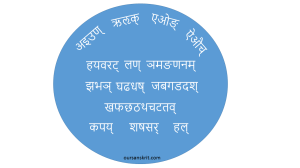 A short YouTube version is available here. [Expand to the full article to be able to click on the link].
A short YouTube version is available here. [Expand to the full article to be able to click on the link].
In the previous lesson, lesson 28, we started looking at the perfect tense, called liṭ लिट् by the Sanskrit grammarians.
We said that in Sanskrit there are three tenses to indicate past action, the imperfect, laṅ लङ्, the aorist, luṅ लुङ् and the perfect, liṭ लिट् . We said that, in classical Sanskrit, in practice, these three tenses seem to be used interchangeably for any past action.
In this lesson we will look at some more paradigms of the perfect tense.
Paradigm 1
Let us take the root √nī √नी “lead” as an example of a conjugation of a root ending in vowels of i or u type. The strong stem is ninay निनय् or nināy निनाय् and the weak stem is ninī निनी.
Active:
| nināya निनाय | ninyatuḥ निन्यतुः | ninyuḥ निन्युः |
| ninayitha निनयिथ OR
ninetha निनेथ |
ninyathuḥ निन्यथुः | ninya निन्य |
| ninaya निनय OR
nināya निनाय |
ninyiva निन्यिव | ninyima निन्यिम |
Middle:
| ninye निन्ये | ninyāte निन्याते | ninyire निन्यिरे |
| ninyiṣe निन्यिषे | ninyāthe निन्याथे | ninyidhve निन्यिध्वे |
| ninye निन्ये | ninyivahe निन्यिवहे | ninyimahe निन्यिमहे |
Paradigm 2
Let us take the very common root √bhū √भू “be”. Only active forms are seen in practice. There is only one stem babhū बभू.
Active:
| babhūva बभूव | babhūvatuḥ बभूवतुः | babhūvuḥ बभूवुः |
| babhūtha बभूथ OR
babhūvitha बभूविथ |
bahbūvathuḥ बह्बूवथुः | babhūva बभूव |
| babhūva बभूव | babhūviva बभूविव | babhūvima बभूविम |
Paradigm 3
Let us take the root √dā √दा “give” as an example of a conjugation of a root ending in ā आ. The stem forms are dadā ददा and dad दद्. Note the au औ ending of 1st and 3rd person singular in the active.
Active:
| dadau ददौ | dadatuḥ ददतुः | daduḥ ददुः |
| dadātha ददाथ OR
daditha ददिथ |
dadathuḥ ददथुः | dada दद |
| dadau ददौ | dadiva ददिव | dadima ददिम |
Middle:
| dade ददे | dadāte ददाते | dadire ददिरे |
| dadiṣe ददिषे | dadāthe ददाथे | dadidhve ददिध्वे |
| dade ददे | dadivahe ददिवहे | dadimahe ददिमहे |
Paradigm 4
Let us take the root √tan √तन् “stretch” as an example of a conjugation of a root with medial a अ, showing fusion of the root and reduplication, resulting in a medial e ए in the weak forms. The strong stem is tatan ततन् or tatān ततान् and the weak stem is ten तेन्.
Active:
| tatāna ततान | tenatuḥ तेनतुः | tenuḥ तेनुः |
| tatantha ततन्थ OR
tenitha तेनिथ |
tenathuḥ तेनथुः | tena तेन |
| tatana ततन OR
tatāna ततान |
teniva तेनिव | tenima तेनिम |
Middle:
| tene तेने | tenāte तेनाते | tenire तेनिरे |
| teniṣe तेनिषे | tenāthe तेनाथे | tenidhve तेनिध्वे |
| tene तेने | tenivahe तेनिवहे | tenimahe तेनिमहे |
Paradigm 5
Let us take the root √vac √वच् “speak” as an example of a conjugation of a root that undergoes “samprasāraṇam” (ie. semivowels change to the corresponding vowels) with the initial va व contracted to u उ in the reduplication. In the strong forms only the reduplicated syllable is contracted, while in the weak forms the radical va व is also contracted to u उ, giving ū ऊ. The strong stem is thus uvac उवच् or uvāc उवाच् and the weak stem is ūc ऊच्.
Active:
| uvāca उवाच | ūcatuḥ ऊचतुः | ūcuḥ ऊचुः |
| uvaktha उवक्थ OR
uvacitha उवचिथ |
ūcathuḥ ऊचथुः | ūca ऊच |
| uvaca उवच OR
uvāca उवाच |
ūciva ऊचिव | ūcima ऊचिम |
Middle:
| ūce ऊचे | ūcāte ऊचाते | ūcire ऊचिरे |
| ūciṣe ऊचिषे | ūcāthe ऊचाथे | ūcidhve ऊचिध्वे |
| ūce ऊचे | ūcivahe ऊचिवहे | ūcimahe ऊचिमहे |
Note:
Four roots ending in r̥ ऋ do not take the union vowel i इ in the first persons dual and plural. These roots are √kr̥ (make) √bhr̥ (bear) √sr̥ (go) √vr̥ (choose) √कृ √भृ √सृ √वृ. For example, the first persons of √कृ √kr̥ are cakara or cakāra; cakr̥va; cakr̥ma चकर or चकार; चकृव; चकृम in the active and cakre cakr̥vahe cakr̥mahe चक्रे चकृवहे चकृमहे in the middle. As an example of a normal r̥ ऋ ending root let us take √dhr̥ √धृ “hold”. Its first persons would be dadhara or dadhāra; dadhriva; dadhrima दधर or दधार; दध्रिव; दध्रिम in the active and dadhre; dadhrivahe; dadhrimahe दध्रे; दध्रिवहे; दध्रिमहे in the middle.
This is the end of lesson 29. In this lesson, we looked at a few paradigms of the perfect tense. We will continue with the perfect tense in the next lesson also.
[…] the previous lessons, lesson 28 and lesson 29, we looked at the perfect tense, called liṭ लिट् by the Sanskrit […]
[…] the previous lessons, lesson 28 , lesson 29 and lesson 30, we looked at the perfect tense, called liṭ लिट् by the Sanskrit […]
[…] the previous lessons, lesson 28, lesson 29, and lesson 30, we looked at the perfect tense, called liṭ लिट् by the Sanskrit […]
[…] indicative, its modes, its participle and an augment perterit, the pluperfect. In lessons 28, 29 and 30, we looked at the indicative and the participle perfect […]
How did we get from nī to Single STEM OF ninay? Where did that “ay” come from? Guna of nī = nai. How did the “y” come there?
It is a combinable version of Vrddhi of nī
So “y य्” is not result of sandhi, but simply a matter of increase ” nī नी ” to vṛddhi (however the combinable version, which I don’t know about).